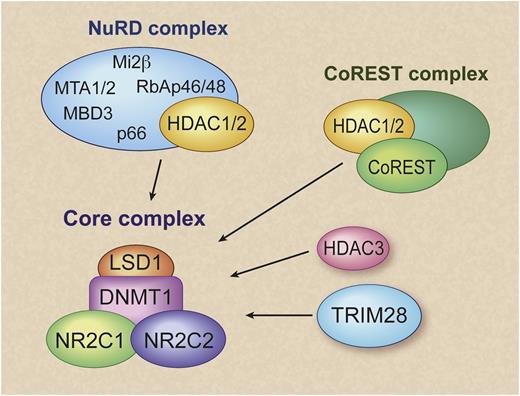In this issue of Blood, Hosoya et al identify a requirement for the corepressor Tripartite Motif Protein 28 (TRIM28) in erythroblast maturation.1
Cartoon showing possible repressor complexes formed through mutually exclusive recruitment of TRIM28, HDAC3, or the NuRD or CoREST complex by the DRED heterodimer of NR2C1 (formerly TR2) and NR2C2 (formerly TR4). The figure has been adapted with permission from Figure 8 in the article by Cui et al.5 Professional illustration by Debra T. Dartez.
Cartoon showing possible repressor complexes formed through mutually exclusive recruitment of TRIM28, HDAC3, or the NuRD or CoREST complex by the DRED heterodimer of NR2C1 (formerly TR2) and NR2C2 (formerly TR4). The figure has been adapted with permission from Figure 8 in the article by Cui et al.5 Professional illustration by Debra T. Dartez.
Erythropoiesis produces billions of new red blood cells on a daily basis in our bone marrow. This process begins with the commitment of hematopoietic stem cells to a hierarchy of progenitors, including the common myeloid progenitor (CMP), the megakaryocyte-erythrocyte progenitor (MEP), and the erythroid lineage-specific burst-forming unit cells (early) and colony-forming unit cells (later). Colony-forming units mature through a tightly orchestrated developmental program in which hemoglobin protein accumulates and organelles such as mitochondria and the nucleus are lost, resulting in the terminally differentiated erythrocytes that enter the bloodstream and transport oxygen to all tissues of the body.2 At different stages of ontogeny, hemoglobin is produced through the sequential expression or “switching” of distinct genes in the embryo, fetus, and adult.3
In the adult, embryonic/fetal β-like globin genes are repressed by transcription factors that include a DNA-binding heterodimer of the orphan nuclear receptors NR2C1 (TR2) and NR2C2 (TR4) (the DRED complex4 ) and an array of epigenetic regulatory cofactors5 (see figure). Hosoya et al1 used conditional gene ablation in adult mice to explore the function of the cofactor TRIM 28 (TRIM28 in humans, Trim28 in the mouse; also known as KRAB-associated protein 1 [KAP1], TIF1β, or KRIP-16 ) in hematopoiesis. TRIM28 is a ubiquitously expressed corepressor that is critical for early embryogenesis (the null mutation is embryonic lethal between embryonic days 5.5 and 8.5 in the mouse) and for the development of a variety of cell lineages, including B cells and T cells. It had not previously been studied in myeloid or erythroid cells.
The authors expected to uncover a role for TRIM28 in repression of embryonic/fetal β-like globin genes in erythroid cells. Such a finding would have been of great clinical interest because induction of fetal hemoglobin F reduces the severity of symptoms in patients with sickle cell anemia, and repressors of the human fetal γ-globin gene are potential targets for therapeutic intervention.3 However, to the authors' surprise, the embryonic/fetal mouse β-like globin genes were not reactivated in adult red blood cells. Instead, the Trim28-deficient mice showed severe normocytic anemia, with disrupted maturation of erythroblasts. Defects in the numbers (increased) of CMPs and MEPs were also identified, suggesting an early function in myeloerythroid cell fate specification. Myelopoiesis was not affected in these mutants.
Interestingly, Gata1 transcription was not affected by loss of Trim28, but the expression of genes encoding several other erythroid transcription factors and heme biosynthetic enzymes was reduced. Expression of apoptosis pathway genes was increased. In addition, as reported recently in another study, Trim28 mutant red cells failed to activate mitophagy-associated genes.7 Together, these observations indicate a crucial early role for Trim28 in erythroid development.
One of the other monikers of TRIM28 is KAP1, from the ability of the protein to interact with Krüppel domain–containing zinc finger proteins. The founding member of the vertebrate erythroid Krüppel-like zinc finger protein family, EKLF/KFL1, is a master regulator of erythropoiesis and can function as either a transcriptional activator or a repressor.8 It will be of interest to determine whether TRIM28 partners with EKLF/KFL1 during erythroid differentiation.
In summary, TRIM28 has critical functions in at least 3 hematopoietic lineages. In maturing erythroblasts, TRIM28 regulates the expression of key transcription factors, heme biosynthetic enzymes, mitochondrial genes, and genes involved in cell survival. TRIM28 is generally considered a corepressor, and it is known to recruit repressors such as HP1 and SETDB1.6 However, coactivator functions have been reported.9,10 Interestingly, RNAseq analysis of 2 large populations of immature erythroblasts identified 1500 to 1600 genes that were downregulated in the Trim28-deficient cells.1 Additional work will be required to determine how many of these genes are direct targets of TRIM28-containing complexes and whether TRIM28 coactivates their expression or represses a repressor.
TRIM28 has been implicated not only in transcriptional regulation but also in the maintenance of genome integrity, organization of chromatin structure, malignant transformation, and in control of retroelements.6 Whether TRIM28 regulates any of these processes in erythroid cells remains to be determined.
Conflict-of-interest disclosure: The author declares no competing financial interests.

